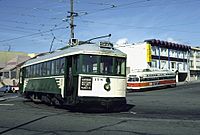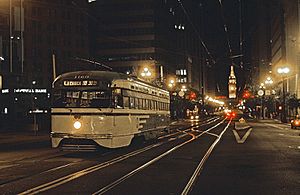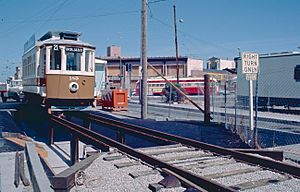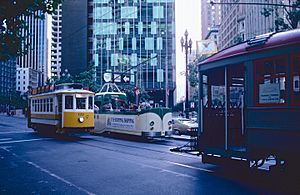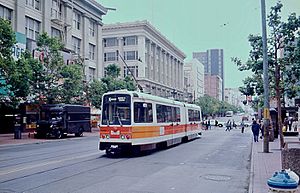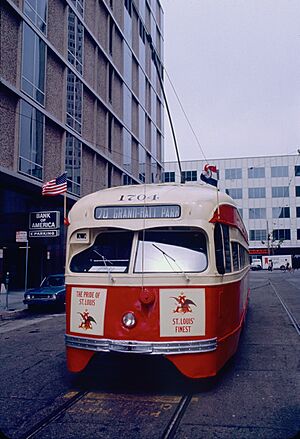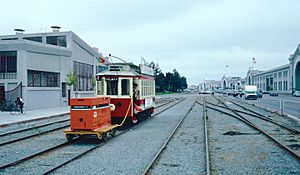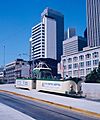San Francisco Historic Trolley Festival facts for kids

Blackpool "boat" car 226 passing Muni car No. 1 on 17th Street in July 1983
|
|
| Overview | |
|---|---|
| Service type | Heritage streetcar |
| Locale | San Francisco, California, U.S. |
| First service | June 23, 1983 |
| Last service | October 17, 1987 |
| Successor | F Market & Wharves streetcar line |
| Former operator(s) | San Francisco Municipal Railway (Muni) |
| Ridership | 3,000+ (1986) |
| Annual ridership | 300,000 (1984) |
| Route | |
| Start | Transbay Terminal |
| End | 17th & Castro streets, Castro District |
| Technical | |
| Rolling stock | Approx. 6–10 streetcars |
| Track gauge | 4 ft 8 1⁄2 in (1,435 mm) (standard gauge) |
| Electrification | Overhead lines, 600 V DC |
The San Francisco Historic Trolley Festival was a special streetcar service in San Francisco, California. It used many old and unique streetcars (also called trolleys) from different countries. This festival ran mostly in the summer, from 1983 to 1987.
The San Francisco Chamber of Commerce and the San Francisco Municipal Railway (Muni) helped run it. This festival was the first step towards the popular F Market & Wharves streetcar line, which started in 1995. The main reason for the festival was that San Francisco's famous cable car system had to close for a long time (about 20 months) starting in September 1982. This was for important repairs. The Trolley Festival was created to give tourists something fun to see and do while the cable cars were away.
At first, the festival was only planned for one summer in 1983, running five days a week. But it became very popular! So, it was brought back every year until 1987. It even ran seven days a week in 1985. Each year, more cool, old streetcars joined the collection. The success of the festival showed that people loved historic trolleys. This helped convince the city to create the permanent F-line streetcar service.
Contents
What Was the Trolley Festival?
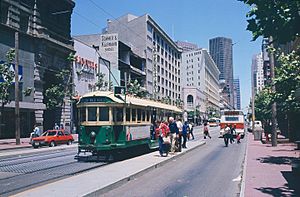
The San Francisco Historic Trolley Festival was a special service that used old streetcars. It ran along Market Street in downtown San Francisco. It operated five to seven days a week, mostly during the summer, from 1983 to 1987. Muni, the city's main public transport agency, ran the festival. The city's Chamber of Commerce and other groups also helped pay for it.
The festival used historic streetcars from many different countries, including Australia, England, Germany, Italy, Japan, Mexico, and Russia. It also featured preserved San Francisco streetcars, some borrowed from museums. The main reason for starting the festival was that the city's famous cable cars needed big repairs. They were closed for about 21 months starting in September 1982. Business owners and city leaders worried that fewer tourists would visit without the cable cars. The festival was a way to keep visitors coming.
The first festival in 1983 was a big hit. Even after the cable cars returned in 1984, the festival kept going because it was so popular. More vintage trolleys were brought in each year to keep things exciting. By 1987, the festival had 10 different trolleys. In 1984, about 300,000 people rode the festival trolleys! The festival became a popular attraction on its own.
How the Festival Started
The idea for the San Francisco Historic Trolley Festival came about in 1982. At that time, the regular streetcar tracks on Market Street were about to stop being used. Also, the city's cable car system was going to close for almost two years for rebuilding.
The cable car system is a National Historic Landmark and a huge tourist draw. But it needed major repairs. So, it was planned to close from September 1982 until June 1984. San Francisco businesses were very worried about losing tourists. A "trolley festival" with old trolleys from around the world was suggested. It would be a fun way to attract visitors while the cable cars were closed, especially during the summer of 1983.
Before the festival, Muni had already started moving its modern streetcar lines (like the J, K, L, M, N lines) into an underground subway. By June 1981, all weekday service was underground. Only on weekends were the old streetcars still running on Market Street. This was set to end completely in September 1982.
In 1981, Muni's own old trolley, car No. 1 (built in 1912), ran special free rides on Market Street. Another old Muni car, No. 178 (built in 1923), was borrowed from a museum. These old cars were very popular with the public. In summer 1982, both cars ran regularly on weekends. Their popularity showed that a full-time service with vintage trolleys could work. The city's leaders supported the idea of continuing vintage streetcar service.
Getting the Festival Ready
The idea for the festival was developed by Muni and the San Francisco Chamber of Commerce. People like Maurice Klebolt, a big fan of trolleys, also helped. Everyone agreed that a festival in 1983 could help with the expected drop in tourism. The Chamber of Commerce became the main sponsor. The Mayor, Dianne Feinstein, and other city officials strongly supported the plan.
Rick Laubscher helped organize the event with Mayor Feinstein. They needed to find old streetcars and choose a route. Muni's own car 1 and car 130 would be used. Car 178 was borrowed again from the Western Railway Museum. Other museums were asked to lend streetcars. The Oregon Electric Railway Museum lent its Portland car 503. The Western Railway Museum also lent a special "boat tram" from Blackpool, England, car 226. Two streetcars from Porto, Portugal, Nos. 122 and 189, were also brought in. Maurice Klebolt arranged for a tram from Melbourne, Australia, to join. The collection of trolleys became very international!
It was decided the festival would run five days a week, from Thursday to Monday. The route would go from the Transbay Terminal along Market Street to 17th & Castro streets. Some of the old streetcars could only go in one direction. These cars would run on the J Church line or turn around at 11th & Market Street. The fares would be the same as regular Muni rides.
On September 19, 1982, regular streetcar service on Market Street ended. A few days later, the cable car system closed for its repairs.
Rick Laubscher presented the festival plan to city groups. His company, Bechtel Corporation, also helped sponsor the event. The Bay Area Electric Railroad Association offered to help train staff and maintain the old trolleys. Laubscher is credited with naming it the "San Francisco Historic Trolley Festival."
Getting Final Approval
The San Francisco Board of Supervisors gave the final approval on February 28, 1983. They set aside almost $350,000 for the service. Other companies also sponsored individual streetcars. For example, the Blackpool "boat" car 226 was sponsored by the Ghirardelli Chocolate Company.
A non-profit group called Market Street Railway also helped. Years later, after the festivals ended, this group became a big supporter of creating a permanent streetcar service on Market Street, which became the F-Market line.
A special area was set up on Duboce Avenue to store and fix the trolleys. This area had tracks that hadn't been used since September 1982. The festival was planned to start in late June.
First Season of Fun
The first San Francisco Historic Trolley Festival began on Thursday, June 23, 1983. It started with a parade of vintage trolleys on Market Street. Mayor Dianne Feinstein drove Muni's car 1 at the front of the parade! Other streetcars in the parade included Porto 122, Blackpool 226, San Francisco 178, and Melbourne 648.
Public service started on June 24 and ran until September 19. It operated five days a week (closed Tuesdays and Wednesdays). Trolleys ran every 15 minutes. The route from the Transbay Terminal to 17th & Castro was about 3.5 miles (5.6 km) long. The route was officially called "F Market & Wharves" from the start, even though it didn't reach Fisherman's Wharf until 2000.
Some trolleys were late joining the festival fleet. So, a modern vehicle, LRV No. 1213, was temporarily added. This car was only six years old! It was special because it was one of the first modern light rail cars built for San Francisco. For the festival, it had old-style trolley poles added so it could run on Market Street.
The Blackpool car, built in 1934, was nicknamed a "boat tram." This was because its low, open-top design looked like a boat "sailing" down the street.
Porto 189 and Portland 503 started service in July. Muni 130 joined in early August. Unfortunately, Milwaukee car 978 was damaged during shipping and never ran.
Also joining the festival were PCC cars 1704 (a Muni car painted to look like a St. Louis car) and Muni 1040. Car 1040 was the very last PCC-type streetcar built in North America (in 1952). Since these cars could only go in one direction, they ran on the J-line or turned around at 11th & Market.
San Francisco Muni's old trolleybus 776 was sometimes part of the festival parades but usually didn't carry passengers.
| City of origin | Car no. | Manufacturer | Year built | Type | Notes | Ref. |
|---|---|---|---|---|---|---|
| San Francisco | 1 | Holman | 1912 | DE, DT | Muni Type A, the first publicly owned big-city streetcar in the U.S. | |
| Porto, Portugal | 122 | J. G. Brill Company | 1909 | DE, ST | Wooden-bodied car | |
| San Francisco | 130 | Jewett | 1914 | DE, DT | Muni Type B, nicknamed "Iron Monsters" | |
| San Francisco | 178 | Bethlehem Shipbuilding Corporation | 1923 | DE, DT | Muni Type K, also nicknamed "Iron Monsters" | |
| Porto, Portugal | 189 | Companhia Carris de Ferro do Porto (CCFP) |
1929 | DE, ST | Wooden-bodied car. Built in Portugal, but based on American-built Brill designs of circa 1912 | |
| Blackpool, England | 226 | English Electric Company | 1934 | DE, DT | Open-top tram, type nicknamed "boat cars". Numbered 601 when retired in Blackpool | |
| Portland, Oregon | 503 | Brill | 1903 | DE, DT | Wooden-bodied car. Also known as a "Council Crest" car | |
| Melbourne, Australia | 648 | M&MTB | 1930 | DE, DT | Wooden-bodied car. Melbourne W2-class | |
| San Francisco | 1040 | St. Louis Car Company | 1952 | SE, DT | PCC streetcar; last one built in North America | |
| San Francisco | 1213 | Boeing-Vertol | 1977 | DE, articulated US Standard Light Rail Vehicle |
One of two prototype LRVs built for Muni; originally numbered 1221 | |
| St. Louis, Missouri | 1704 | St. Louis Car Company | 1946 | SE, DT | PCC streetcar, formerly known as San Francisco Muni 1128 and still owned by Muni, but originally operated on the St. Louis streetcar system | |
| Hamburg, Germany | 3557 | Linke-Hofmann-Busch | 1954 | SE, DT | Nicknamed the "Red Baron" in San Francisco | |
| Abbreviations for general types: DE: double-ended; SE: single-ended; DT: double-truck; ST: single-truck. | ||||||
Hamburg 3557, a car donated to the city in 1979, was not originally planned for the festival. But it was prepared and entered service just two days before the first festival season ended.
After the First Season
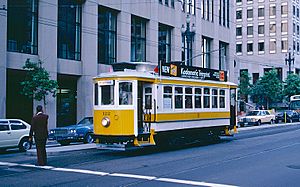
After the main festival ended on September 19, 1983, another parade was held. Because the festival was so popular, Muni decided to keep it going on Saturdays and Sundays through the Christmas season and into January. Some streetcars left San Francisco after the 1983 season. Porto 122 was sold and moved to Dallas, Texas. But Muni bought Porto 189, making it a permanent part of the fleet.
The modern LRV 1213 ran for one week in the 1984 festival. But it was then needed for regular Muni Metro service, so its trolley poles were removed.
Embarcadero Demonstration
In 1987, a special streetcar service ran along the Embarcadero for five weeks. There had been ideas for a historic streetcar line there for years. The old freight tracks along the Embarcadero were no longer used. Maurice Klebolt suggested a short demonstration to see if a regular service would work.
Muni agreed, and the city approved it. Since there were no overhead wires for electricity on these tracks, the streetcars had to be powered by diesel generators. These generators were pulled or pushed by the streetcars on small trailers. Two streetcars were used: San Francisco car 578 (built in 1895) and Porto car 189 (built in 1929).
This special service ran from September 11 to October 17, 1987.
What Came Next
The five years of the Historic Trolley Festival were very important. They showed the public and businesses how much people loved historic streetcars. This strong support helped lead to the creation of the permanent, year-round F-line streetcar service, which finally opened in 1995.
Images for kids
-
San Francisco Muni's own trolleybus 776, built in 1950, in regular service during the 1987 festival.




